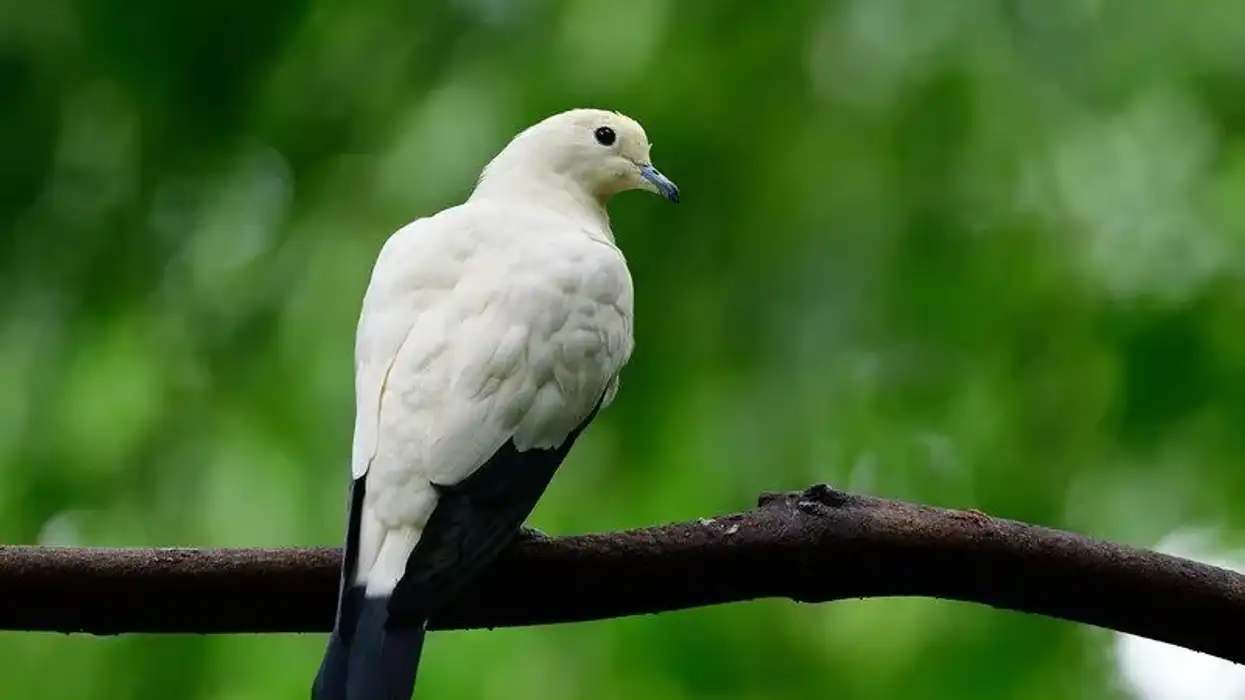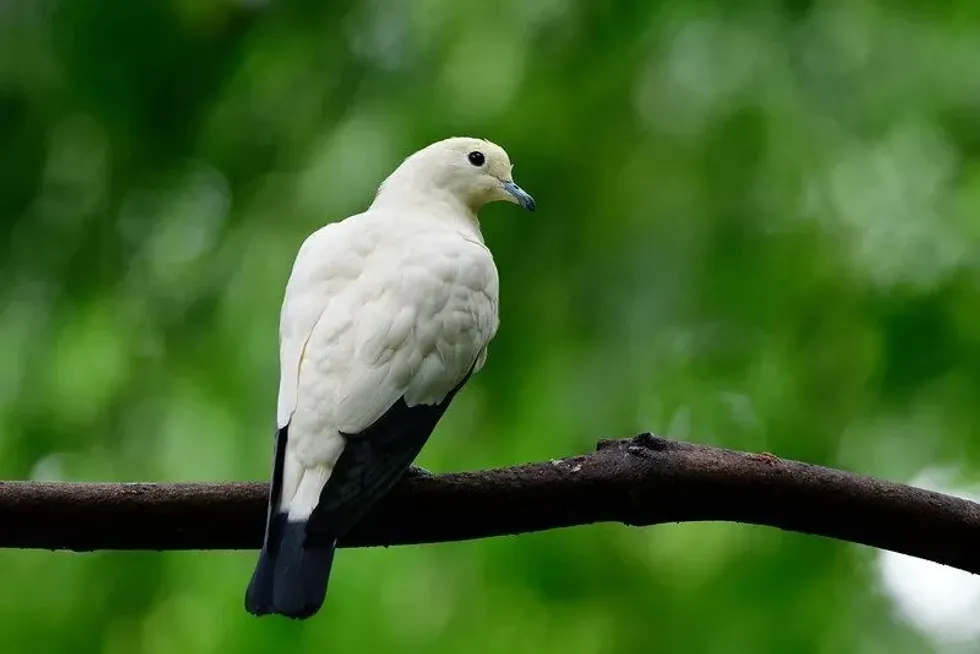The pied imperial pigeon (Ducula bicolor) is a species of pigeon found in woodland, forests, plantations, mangroves, and scrub habitats.
This is a relatively large species of pigeon and is called pied due to the unpigmented white spots on a pigmented background/body of feathers. The bird species is found in coastal regions and on small islands.
This pigeon, pied imperial pigeon (Ducula bicolor) is found in its natural habitat and also in a zoo habitat. The bird is often called nutmeg.
In the natural habitat, the pied imperial pigeon is seen in southeast Asia in Myanmar, Indonesia, Thailand, the Philippines, and New Guinea. In Indonesia, this pigeon is known as balud-puti and camasu locally.
IUCN Red List and BirdLife International deem this pigeon species as the Least Concern as the bird is very common locally. The taxonomy of this species still remains confusing, however, this large bird is considered a part of the genus Ducula.
This is a migratory bird that travels in flocks and is seen mostly during dusk and dawn. This pigeon, pied imperial pigeon is considered to be one of the most agile and powerful fliers among birds and this large bird has bigger flight muscles than most in the bird world.
The large flight muscles help the birds in migration as with these, they can cross the large range of water bodies easily. The pied imperial pigeon migrate to other islands easily using the large body and larger muscles.
Pied Imperial Pigeon Interesting Facts
What type of animal is a pied imperial pigeon?
Pied imperial pigeon (or nutmeg) is a type of pigeon and the population of the species of birds is found in the wild as well as in a zoo.
What class of animal does a pied imperial pigeon belong to?
Pied imperial pigeon is a part of the class of Aves in the kingdom of animals. It falls under the family of Columbidae.
Many-a-times this pigeon, pied imperial pigeon, has had the subspecies the Torresian, yellowish, and silver-tipped imperial pigeons under it. However, it still remains confusing, and the widespread known subspecies of the pied imperial pigeon are differentiated by the above-mentioned ones by white thighs and also under tail coverts. The pied imperial pigeon also has a dark-tipped bluish bill.
There are similar species like silver-tipped pigeons and torresian imperial pigeons.
How many pied imperial pigeons are there in the world?
The total population of the species is not known as there is no threat to the birds currently. All over the world, in all the range of habitats (wild or zoo), these birds are abundantly found.
The conservation status is also the least concern and breeding is also seen in full form. Only in Australia, the bird species are known to be 500,000 strong.
Where does a pied imperial pigeon live?
These birds are abundantly found in forests, plantations, woodland, scrub, and mangroves. You will find a large population of this pigeon on offshore islands and also in the mainland of north-east and northern Australia.
Find a pied imperial pigeon in the wild in a range of wooded habitats including a rain forest, a mangrove area, a Eucalyptus forest, and a Melaleuca forest.
Often you won't find these birds in arid areas. The birds stay high on the branches of trees and if not trees, then on telephone and power lines in the mainland.
What is a pied imperial pigeon's habitat?
The pied imperial pigeon range map includes north-east and north Australia, Southeast Asia, with a range of Myanmar and Thailand and then throughout Indonesia. Find the bird also towards the east to the Philippines and the Bird's Head Peninsula found in New Guinea.
Find the birds in a forest, woodland, plantations, mangrove, and scrub mainly seen in small islands and in coastal areas.
Who do pied imperial pigeons live with?
You will always find these birds in flocks of ten or even more sitting at the tip of trees or other high objects. They move in colonies.
How long does a pied imperial pigeon live?
Usually, the bird lives for around 20 years. Zoo animals might live longer than wild ones, due to a better diet. The birds in mainland areas might have a shorter lifespan.
How do they reproduce?
The breeding season starts in January. From January to March, a pied imperial pigeon nest is made using sticks and mostly in the tip of coconut palms. The nest is made untidy.
Only one or two eggs are laid and two or more broods are seen each year on coconut trees. Pied imperial pigeon eggs are incubated by both males and females.
Males incubate during the day and females at night. The chicks will be able to fly in two or three weeks. Including the nesting period, the gestation time is around 25-30 days.
Each year, two or three broods of the nutmeg will be seen in the small nest atop a coconut palm tree. Colonies are seen of these birds.
What is their conservation status?
The conservation status of the bird is the Least Concern as given by IUCN Red List. The population is quite high in the islands of the wild as well as zoo habitats, however, there are some places where due to human interference, breeding birds have been affected near the coastal regions.
Breeding should not be disturbed and the nest in the wild should be left unharmed.
Pied Imperial Pigeon Fun Facts
What do pied imperial pigeons look like?
The bird is large in size and has a distinctive black and white body. Black coloration is seen on the outer areas of the wings and on the tail tip.
Black bars are seen on the underpart of the tail. Feet and legs are blue-gray while yellow or yellow-green beaks are seen on white bodies. They have strong feathers and muscles.
Unlike other small species of pigeons, these are quite large and live in colonies.
Some researchers still call the bird Imperial Pigeon, Nutmeg, Torresian Imperial, and Torres Strait Pigeon.
How cute are they?
Pigeons are very cute in general.
How do they communicate?
The calls of the bird include 'mrrrooooo', 'up-ooooo', and 'roo-ca-hoo'. Imagine hearing the calls of ten or more birds together.
How big is a pied imperial pigeon?
Pied imperial pigeon species is quite large in size when compared to other species of pigeon birds. The length of these birds is about 14-17.6 in (35.5-44.7 cm).
A pied imperial pigeon wingspan is about 18 in (45.7 cm).
How fast can a pied imperial pigeon fly?
The pied imperial pigeon flying trait is really strong and agile which is complemented by the large flight muscles in the wings. Apart from strong feathers, their bodies also help in flying. Speed is not known.
How much does a pied imperial pigeon weigh?
The weight is between 0.8-1.12 lb (362-508 g).
What are the male and female names of the species?
Males and female species do not have different names.
What would you call a baby pied imperial pigeon?
A pied imperial pigeon baby is called a chick like any other species of bird. Some also call them squab.
What do they eat?
The pied imperial pigeon zoo species have food like seeds, grains, and fruits while living in the wild. In the zoo, the bird is given vegetables and fruits.
Are they dangerous?
They are not at all dangerous.
Would they make a good pet?
They are not usually kept as pets. You can see some in the zoo.
Did you know...
Their diet can include very large fruits with big seeds. They either gulp down the whole fruits with the seeds or eject the seeds after pulps have been injected.
Are pied imperial pigeons endangered?
They are found commonly in all habitats.
Do pied imperial pigeons migrate?
Yes, these birds migrate. Many consider these birds as non-migratory, but their migratory nature has been seen in different islands across its range. Some non-migratory birds might be observed in the pied imperial pigeon Australia range.










